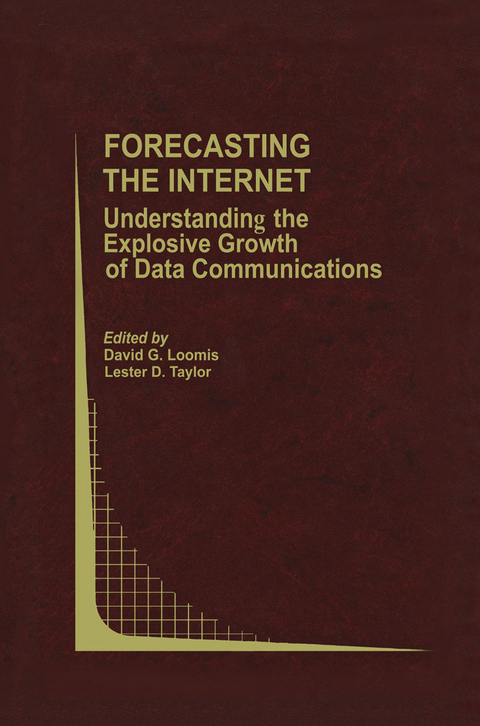
Forecasting the Internet
Understanding the Explosive Growth of Data Communications
Seiten
2001
Springer (Verlag)
978-0-7923-7546-3 (ISBN)
Springer (Verlag)
978-0-7923-7546-3 (ISBN)
Even as business demand for data communications is becoming better understood, residential broadband access demand is still largely unexplored. Demand for Internet access is derived from the demand for applications which utilize this access;
David O. Loomis Illinois State University The explosive growth of the Internet has caught most industry experts off guard. While data communications was expected to be the "wave of the future," few industry observers foresaw how rapid the change in focus from voice communications towards data would be. Understanding the data communications revolution has become an urgent priority for many in the telecommunications industry. Demand analysis and forecasting are critical tools to understanding these trends for both Internet access and Internet backbone service. Businesses have led residential customers in the demand for data services, but residential demand is currently increasing exponentiall y. Even as business demand for data communications is becoming better understood, residential broadband access demand is still largely unexplored. Cable modems and ADSL appear to be the current residential broadband choices yet demand elasticities and econometric model-based forecasts for these services are not currently available. The responsiveness of customers to price and income changes and customer's perceptions of the tradeoff in product characteristics between cable modems and ADSL is largely unknown. Demand for Internet access is derived from the demand for applications which utilize this access; access is not demanded independent of its usage. Thus it is important to understand Internet applications in order to understand the demand for access.
David O. Loomis Illinois State University The explosive growth of the Internet has caught most industry experts off guard. While data communications was expected to be the "wave of the future," few industry observers foresaw how rapid the change in focus from voice communications towards data would be. Understanding the data communications revolution has become an urgent priority for many in the telecommunications industry. Demand analysis and forecasting are critical tools to understanding these trends for both Internet access and Internet backbone service. Businesses have led residential customers in the demand for data services, but residential demand is currently increasing exponentiall y. Even as business demand for data communications is becoming better understood, residential broadband access demand is still largely unexplored. Cable modems and ADSL appear to be the current residential broadband choices yet demand elasticities and econometric model-based forecasts for these services are not currently available. The responsiveness of customers to price and income changes and customer's perceptions of the tradeoff in product characteristics between cable modems and ADSL is largely unknown. Demand for Internet access is derived from the demand for applications which utilize this access; access is not demanded independent of its usage. Thus it is important to understand Internet applications in order to understand the demand for access.
1. Introduction.- 2. Forecasting the Internet.- 3. The Demand for High-Speed Access to the Internet.- 4. What Drives Internet Demand in the UK?.- 5. Forecasts for Internet/Online Access.- 6. Forecasting the Residential Data-Wave.- 7. On Forecasting the Demand for E-Commerce.- 8. Internet Forecasting and the Economics of Networks.- 9. Bandwidth Forecasting: A Techno-Economic Approach.- 10.The Increasing Importance of Broadband Services and its Reflection in European Telecommunications Regulation.- 11.The Internet: Market and Regulatory Conundrums.- 12.U. S. Broadband Pricing and Alternatives for Internet Service Providers.- Indes.
| Erscheint lt. Verlag | 30.11.2001 |
|---|---|
| Reihe/Serie | Topics in Regulatory Economics and Policy ; 39 |
| Zusatzinfo | XV, 250 p. |
| Verlagsort | Dordrecht |
| Sprache | englisch |
| Maße | 155 x 235 mm |
| Themenwelt | Wirtschaft ► Betriebswirtschaft / Management ► Wirtschaftsinformatik |
| Wirtschaft ► Volkswirtschaftslehre ► Makroökonomie | |
| ISBN-10 | 0-7923-7546-7 / 0792375467 |
| ISBN-13 | 978-0-7923-7546-3 / 9780792375463 |
| Zustand | Neuware |
| Haben Sie eine Frage zum Produkt? |
Mehr entdecken
aus dem Bereich
aus dem Bereich
Technologische Trends und betriebliche Informationssysteme
Buch | Softcover (2022)
Schäffer-Poeschel (Verlag)
CHF 48,95


